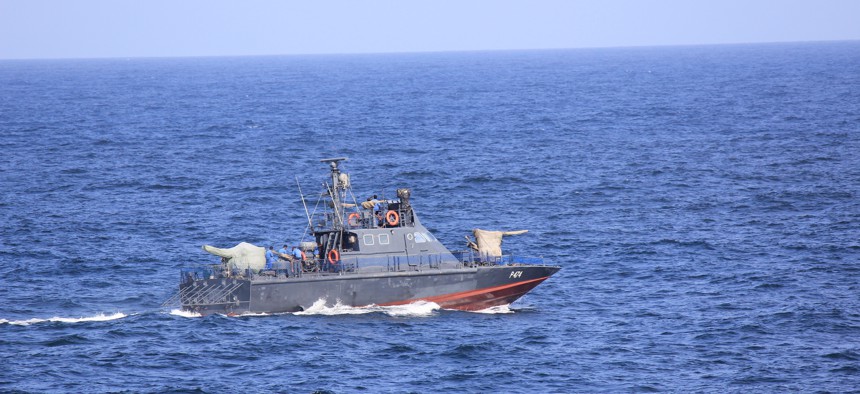
A patrol boat of the Sri Lankan navy patrols in the port of Colombo, Sri Lanka, in 2011. Catmiff / Shutterstock
How Smaller States are Choosing Sides in the Indian Ocean
From Sri Lanka to Kenya, governments try to balance major-power influence — except in arms purchases.
As India and China have intensified their geopolitical interest in the Indian Ocean, the region’s smaller states have aimed to balance their political relations with these major powers. But in at least one realm of engagement, countries have resisted balancing their relations. Since 2015, the island countries of Mauritius, Seychelles, and Sri Lanka have procured military equipment only from India, while the coastal countries of Bangladesh, Djibouti, Kenya, Myanmar, Pakistan, and Tanzania have bought solely from China.
This timeframe is significant because it was in January 2015 that the U.S and India issued and unprecedented Joint Strategic Vision for the Asia-Pacific and Indian Ocean Region. This was shortly after followed by Prime Minister Narendra Modi’s own announcement of India’s “Security and Growth for All in the Region,” or SAGAR, program a multifaceted effort to engage politically, diplomatically, economically and on security matters with Indian Ocean island states.
The strategic significance of the area’s island states — notably Sri Lanka, Mauritius, Maldives and the Seychelles — arises primarily from their proximity to key international sea lanes. China, India, Japan, and the United States each have some cooperative but otherwise mostly competing interests and projects in these states, largely for capacity building. Yet these states do have agency and their own agendas, influenced by domestic factors, in their relations with the major powers.
Related: Who Will Prevent the Next India-Pakistan War?
Related: Naval Task Groups Are Proliferating in the Indo-Pacific
Related: China’s Growing Power Is Bringing Military Drills Center Stage in Asia
Under Prime Minister Modi, India has engaged more substantively with each of these states on defense and security. At the same time, China, under the banner of the Maritime Silk Road and the wider Belt and Road Initiative, has substantially increased its involvement in Sri Lanka, Maldives, and the Seychelles; Mauritius is also set to join the initiative. And as China increases its naval activities in the region, Japan, Britain, and the United States are also increasing their relationships with the smaller states. All this adds potential points of contention between those major powers, with commensurate prospects of spilling into the regional states.
Sri Lanka’s dealings illustrate how the smaller states are working to balance influence and investment by regional powers. China is the major investor in the $1.4 billion Colombo Port City project. Beijing also designed the December 2017 debt-for-equity swap — China calls it a public-private partnership investment — in which Sri Lanka handed over a controlling stake in the southern port of Hambantota and 15,000 acres of surrounding land to China on a 99-year-long lease in return for $1.1 billion in debt relief. But Sri Lanka has also accepted infrastructural investment from other sources. In January 2018, India provided more than $45 million to build a commercial port in the northern harbour at Kankesanthurai, and now is offering some $2 billion to develop the port, oil terminals, and refinery at Trincomalee in northeastern Sri Lanka. As well, on 28 May, India, Japan and Sri Lanka agreed to develop the second foreign-operated container terminal at Colombo port as a joint venture.
And yet neither Sri Lanka nor its small neighbors have so finely balanced their arms imports, according to the Military Balance+ database produced by the International Institute for Strategic Studies, or IISS. This sole-sourcing represents a change for Sri Lanka, which bought Chinese arms during its civil war that ended in 2009, and for Seychelles, which bought from China two light transport aircraft in 2011 and a patrol boat in 2014.
The range and quantity of these purchases also varies. India’s regional customers have procured solely maritime-security-focused equipment, including donated boats. Mauritius bought 12 coastal patrol craft and patrol boats; Seychelles, one maritime patrol aircraft; and Sri Lanka, three offshore patrol ships and ocean-going patrol craft. But Chinese arms sales to the region include a wider selection of air and land as well as maritime security equipment. Pakistan is the biggest customer, having bought 610 main battle tanks and 100 JF-17 fighter ground-attack aircraft. Other sales include Bangladesh’s purchase of 47 main battle tanks and armored recovery vehicles; Kenya’s 30 light forces vehicles; and Tanzania’s 24 light tanks.
Each of these defense contracts depends on India and China’s capacity to deliver equipment to the smaller states, as well as the willingness and financial capacity of each of the smaller states to procure from the two powers. China has a more extensive defense industrial base, suggesting a greater capacity to efficiently meet its delivery obligations. Meanwhile, the Indian government is working to strengthen its own industrial base via the “Make in India” policy, yet many equipment projects have experienced delays and cost overruns.
This state of either-or defense procurement has now come to an end. On 8 July, Sri Lanka received a donated Chinese frigate, and that may encourage its neighbors to become more ecumenical in their own purchases. And it may augur a new phase of bolder strategic initiative from Indian Ocean countries in their own abilities to balance major-power influences — and a new arena of competition for those powers themselves.